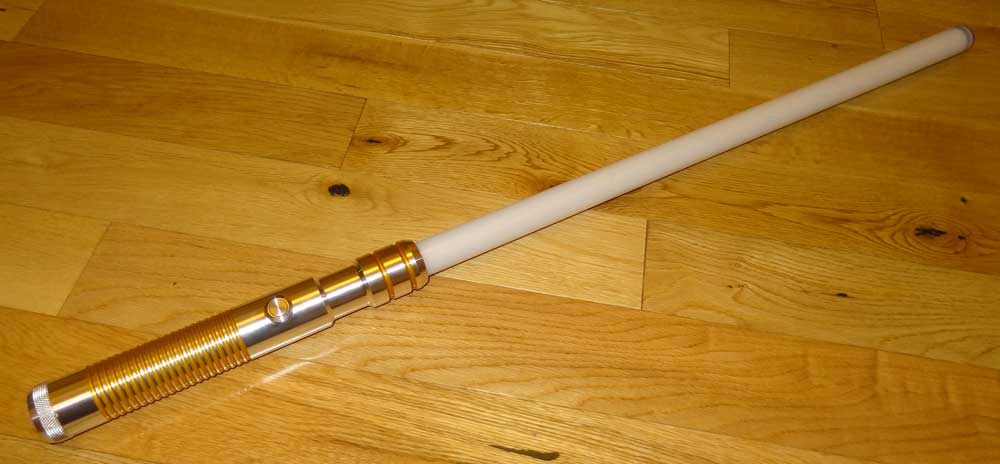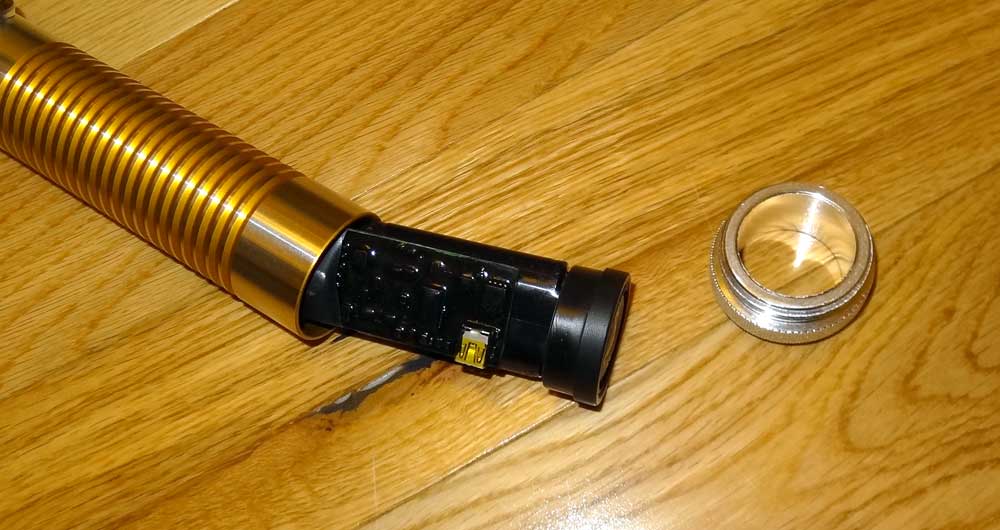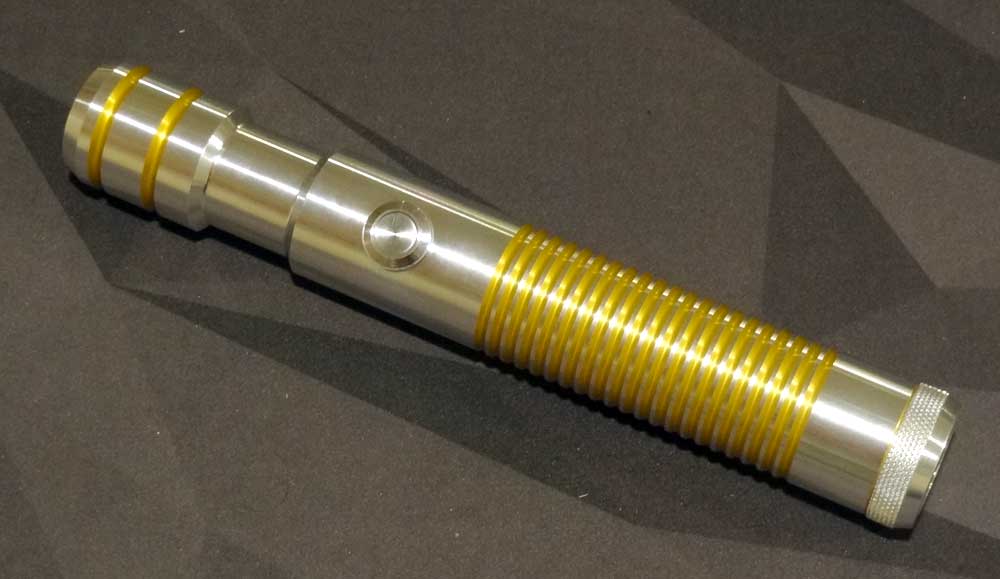
As you may know, I have a young Sith-in-training who is fast becoming the biggest Star Wars geek in our house. So when Ultrasabers asked if I wanted to try out one of their Ultrasabers, I knew it was, ahem, useless to resist.
Ultrasabers has a huge selection of sabers with a wide variety of options for the look and sound. For review purposes, they sent me one of the lower-priced hilts, the Initiate v4, fitted out with the Obsidian LITE Soundboard for the basic sound effects, and the 24″ blade (more manageable for young Padawans). It has a blue blade, with the “Flash on Clash” option–more on that in a bit. The hilt itself is made of aircraft aluminum and has a nice heft to it; the blade is made of polycarbonate and is sturdy enough to fight with–you would be unwise to lower your defenses. (Since we just have the one light saber we haven’t had too many duels just yet.) The whole thing is powered by 2 AA lithium-ion rechargeable batteries.

This saber has a few basic effects: you push the button to turn it on (with the familiar psssssshhhewwww power-up sound, followed by the constant humming), and when you swing it around you get the vwooom vwooooom sounds that we’ve all been making with our mouths for years. The Flash on Clash option means that when the saber detects an impact, it flashes a different color (in my case, silver) and plays a clash sound. There are multiple sounds for both the swinging and clashing. You can also tap the button to get a “lock-up” effect, where the blade flashes continuously and plays the zapping sound made when two light sabers are locked up against each other. Finally, pressing and holding the button turns the saber off, accompanied by the sound effect.
The impact has to be pretty strong to get the clash effect, in my experience–we whacked at a pillow pretty hard and it would play the sound most, but not all, of the time. I was, however, able to get a clashing noise if I jerked the blade to a stop, pretending to hit an imaginary target (as you can see in the video), but my kids couldn’t quite get that snap to work for them. However, if you actually duel with the sabers, there would be a good, solid impact to trigger the sound. The swinging noise doesn’t require quite as vigorous swinging, but if you swing it too slowly sometimes it doesn’t play the noise.
The sound comes from a small speaker in the end of the hilt, and it’s pretty impressive how loud it is–and how easy it is to shut out most of the sound if you put your hand over the end of the hilt. That’s also where you change the batteries–unscrew the bottom of the hilt, slide the battery compartment out (but not too far, or you could damage the wires inside), and then swap out the batteries.

Aside from the huge variety of hilts to choose from (including double-bladed sabers and sabers with cross-guards similar to Kylo Ren’s), you get to customize just about everything else, too. The length of the blade, the color of the blade (and the flash), whether it has sound or not, and the type of sound it includes. You can get a covertec wheel in case you want to attach it to a clip on your costume, and there’s also a blade plug that you can put on the top of the saber if you want to remove the blade but have it still look cool. And if you just want a prop handle without the electronics inside, you can get that, too.

There are a couple of options for the blade: mid grade and heavy grade, and each comes in regular and “UltraEdge” flavors. The mid grade is lighter but allows for more of the light to shine through, and the heavy grade sacrifices a little bit of the light in favor of strength. The UltraEdge has a white polycarbonate tube (as opposed to a clear tube), so it’s still quite bright but not as bright as the completely clear version. It also means that, when turned off, the blade is white rather than see-through. (Mine has the UltraEdge mid grade blade.) If you’re planning to do a lot of dueling, you would probably want a heavy grade option, but the mid grade is good for casual play.
The Obsidian LITE soundboard has all the familiar sounds but you can’t plug the saber into a USB port to customize it. The Premium Sound option will give you access to sound fonts, so you can actually choose the different sound effects the saber makes. And there’s also an Emerald Saber option that gives you nearly unlimited control over your saber: you’ll be able to use pulse mode, changing between two different colors, and adjust the timing of the pulse. You also have control over the Flash on Clash option. It’s a pretty amazing setup if you want to switch up your saber for different events, though of course it comes at a premium price.

Overall, I was really pleased by the quality of the Ultrasaber, and my kids have really been enjoying it. The quality doesn’t come cheap, though there are definitely a range of options. Empty hilts run from $29.99 to $184.00, and depending on your choice of lights, color, and sound, you could spend up to $500. You can also buy parts separately if you want to build your own. My saber setup would be $209.99, for instance–it’s a cheaper hilt but does have the Flash on Clash option.
If you’re looking for a high-end custom light saber, Ultrasabers are impressive. Most impressive.
Disclosure: Review sample provided by Ultrasabers. Opinions are my own.

